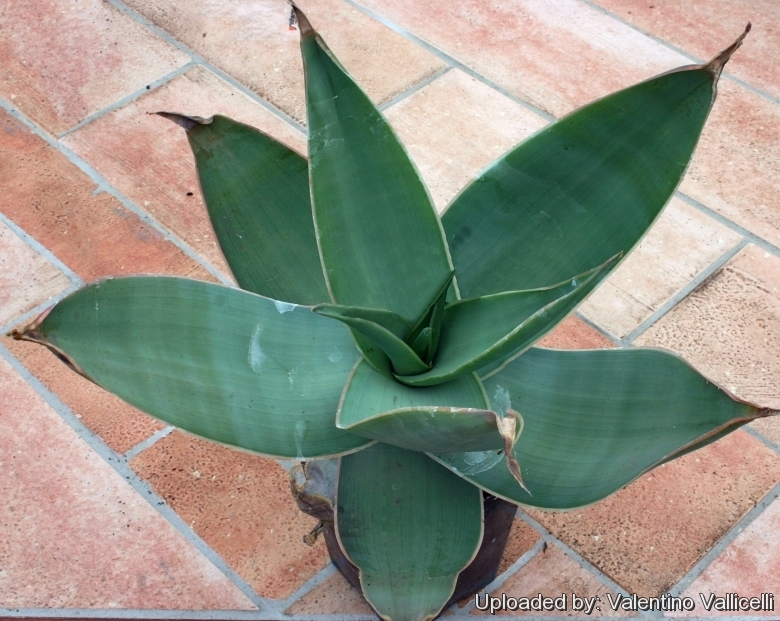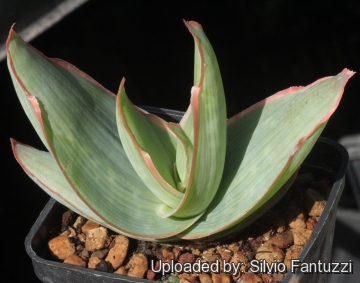




Your support is critical to our success.

Origin and Habitat: Transkei, Eastern Cape, South Africa.
Altitude: From low elevations to 1000 metres above sea level.
Type locality: above a waterfall of the Xobo River, about 137 km east of Idutywa, Transkei, at an altitude of 765 m.
Habitat: Aloe reynoldsiiSN|763]]SN|763]] is a natural cliff-dweller, thriving in river valleys on almost vertical walls, rock faces and steep grassy slopes mostly in inaccessible positions between and under bushes and on ledges of rock cliffs. Often it grows in cracks between boulders along with other succulent plants like Crassula falcataSN|11182]]SN|11182]], in frost-free areas with a high humidity factor. Rainfall is in summer.
Synonyms:
- Aloe reynoldsii Letty
ENGLISH: Reynold's Aloe
Description: Aloe reynoldsiiSN|685]]SN|763]] is one of the stemless spotted leaf aloes that is very like Aloe striataSN|763]]SN|685]] except for the flower colour and the subtle mottling of the leaves.
Habit: It is a low-growing rosetted plant, clumping with maturity.
Rosettes: 14-20-leaved, 45-60 or more cm tall and in diameter.
Stem: Acaulescent or shortly caulescent, eventually 15-20 cm tall and covered by the remains of dead leaves.
Leaves: Flat, broad, elongated, fleshy, floppy, with a waxy texture, 35 cm long, 11 cm broad, grey green to yellowish-green that turns pinky to pale blue in winter sun, distinctly lineate with longitudinal striations and often subtly mottled on both surfaces with oblong or 'H' shaped cream to greyish-green spots. Margin, wavy, pinkish red, toothless or with minute, white, soft teeth.
Inflorescence: Paniculate. Very slender, 40-60 cm tall with 4-5 branches, racemes subcapitate laxly flowered.
Flowers: Delicate yellow to yellow-orange, tubular, slightly swollen at the base.
Blooming season: Spring.
Bibliography: Major references and further lectures
1) Urs Eggli “Illustrated Handbook of Suculent Plants: Monocotyledons” Springer, 2001. Pages 114-115
2) Susan Carter, John J. Lavranos, Leonard E. Newton, Colin C. Walker “Aloes. The definitive guide.” Kew Publishing, Royal Botanic Gardens, Kew 2011
3) Court, D, 1981. “Succulent flora of Southern Africa” Balkema, Cape Town.
4) Germishuizen, G. & Meyer, N.L. (eds) 2003. “Plants of southern Africa: an annotated checklist.” Strelitzia 14. National Botanical Institute, Pretoria.
5) Kristo Pienaar “South African 'What Flower Is That'?” Struik, 01/Aug/2003
6) Nichols, G. 2005. “Growing rare plants, a practical handbook on propagating the treatened plants of southern Africa” Southern African Botanical Diversity Network Report No. 36. SABONET, Pretoria .
7) Gilbert Westacott Reynolds “The aloes of South Africa” A.A. Balkema, 1974
8) Van Jaarsveld, E., Van Wyk, B-E. & Smith, G. 2000. “Succulents of South Africa” Cape Town , Tafelberg
9) Van Wyk, B-E. & Smith, G. 1996. “Guide to the aloes of South Africa” Briza Publications, Pretoria.
10) Williamson, G. 2000. “Richtersveld. The enchanted wilderness” Umdaus Press, Hatfield.
11) Hans Bornman, David S. Hardy “Aloes of the South African veld” Voortrekkerpers, 1971
12) Barbara Jeppe “South African aloes” Purnell, 1974
13) Ben-Erik Van Wyk, Gideon Smith “Guide to the Aloes of South Africa” 2nd edition, 2003

Aloe reynoldsii Photo by: Silvio Fantuzzi

Aloe reynoldsii Photo by: Valentino Vallicelli

Aloe reynoldsii Photo by: Valentino Vallicelli
The gallery now contains thousands of pictures, however it is possible to do even more. We are, of course, seeking photos of species not yet shown in the gallery but not only that, we are also looking for better pictures than those already present. Read More...
Cultivation and Propagation: It is easy to cultivate under a wide variety of climatic conditions provided it is planted in a well-drained situation given adequate water but not over-watered.
Soil: Grow it in an open sandy-gritty well-drained cactus compost, with a slightly acidic pH (5-6).
Pots: It needs a relatively shallow pot to accommodate its fibrous roots and provide a very good drainage. It may stay in the same pot for many years.
Watering: Water in moderation. Keep dry in winter or when night temperatures remain below 10° C. Water it less than average if in bigger pots.
Special need: Provide very good ventilation. Nearly all problems occur as a result of overwatering and poor ventilation, especially when weather conditions are dull and cool or very humid.
Fertilization: Light fertilizer seems to boost its growth whenever additional water is given. Feed it during the growing season with a fertilizer specifically formulated for cactus and succulents (high potash fertilizer with a dilute low nitrogen), including all micro nutrients and trace elements diluted to ½ the strength recommended on the label. It thrive in poor soils and needs a limited supplies of fertilizer to avoid the plant developing excess vegetation, which is easily attacked by fungal diseases.
Exposure: It enjoys light-shade. It may be grown in full sun too but protect in summer from afternoon sun, and avoid reflected heat. It will do its best with some sun and become stressed with inadequate light which could result in poor growth and unnatural shape. Direct sunlight along with prolonged drought and make the leaves turn a reddish colour, a sign generally associated with stress.
Hardiness: It likes warmth (recommended minimum winter temperature 5° C) however plants kept perfectly dry can can survive low temperatures, approx. -2° for short periods with minimum damage, but for safe cultivation it is best to avoid freezing temperatures.
Pest and diseases: Occasionally these plants are infested by scale and aphids, but all known garden pests can be kept to a minimum by simply ensuring optimal growing conditions and healthy plants.
Use: This is suited for a non heated green house. It can be also cultivated outdoors in raised beds, terraces if sheltered from winter rain. This aloe continues to be, a particular prize among collectors
Maintenance: Removal of old flower stalks.
Propagation: Suckers, division of older plants. Seeds must be sown as fresh as possible. The best time for sowing would be in the late summer before winter sets in when temperatures are still warm. Use coarse, well-drained sandy soil and cover seeds lightly, then keep moist. Cover the seeds with a fine layer of grit and water from below with a with a long-lasting fungicide, as seedlings are prone to damping off, a fungus that eventually kills the young plants. For the 1-2 weeks cover the pots with a sheet of glass/clear perspex to keep the humidity levels high. Remove the glass and replace it with light shade-cloth and mist once or twice a day for the next two weeks after which most seeds should have germinated. From then on mistings can be reduced to every second and then every third day as the little plants grow. After germination, when plants are about 20–30 mm high, re-plant seedlings using a sandy loam medium and feed with organic fertilizer at least once a quarter to ensure healthy growth. By cuttings: remove offspring from the parent plant. Place the cuttings in the same mixture one uses for seeds. Use root hormone to stimulate root growth.
| Your Actions | |
|---|---|
| Back to Aloe index | |
| Back to Aloaceae index | |
 |
Back to Succulents Encyclopedia index |
Privacy stantement - Terms and conditions - How to cite - About us - Feedback - Donate




